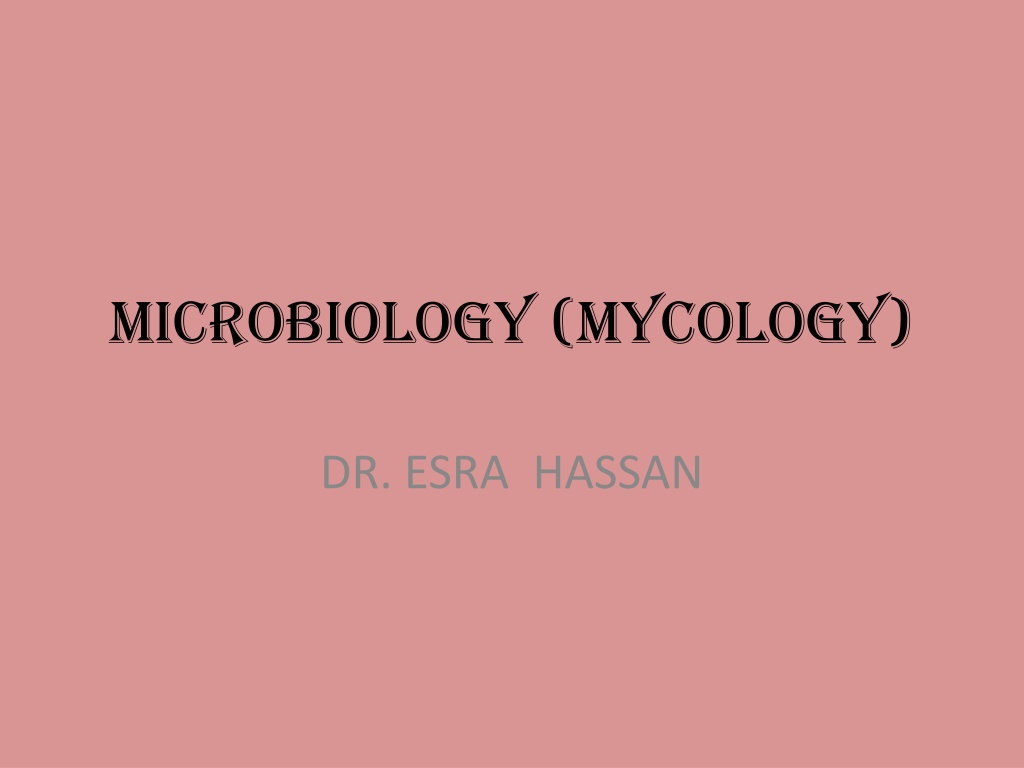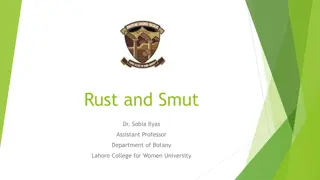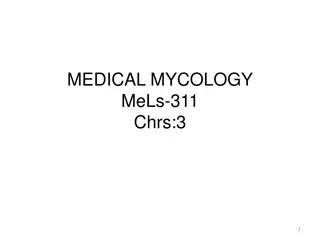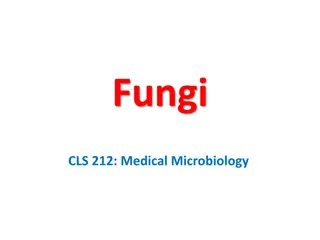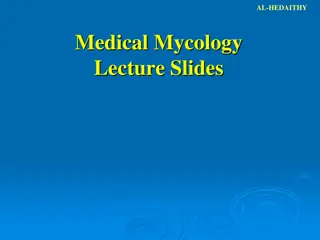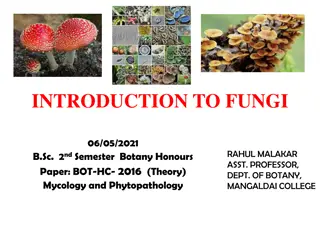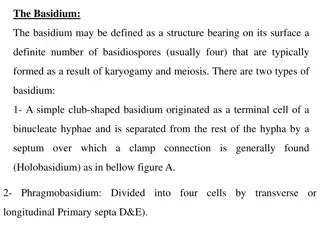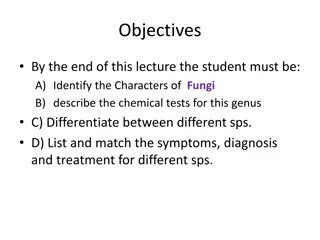Understanding Fungi: A Brief Overview of Mycology in Microbiology by Dr. Esra Hassan
Fungi, classified as living eukaryotic microorganisms, exhibit diverse structural forms such as yeasts and molds in mycology. This field explores the characteristics, pathogenicity, and importance of fungi, particularly Candida in oral mycology. Discover the fundamental concepts of morphology, hyphae structures, and the role of medically important fungi in causing infections, impacting both immunocompromised and general populations.
Download Presentation

Please find below an Image/Link to download the presentation.
The content on the website is provided AS IS for your information and personal use only. It may not be sold, licensed, or shared on other websites without obtaining consent from the author. Download presentation by click this link. If you encounter any issues during the download, it is possible that the publisher has removed the file from their server.
E N D
Presentation Transcript
MICROBIOLOGY (MYCOLOGY) DR. ESRA HASSAN
MYCOLOGY Fungi are living eukaryotic microorganisms, characterized by forming a thin slender, branching thread like (filamentous) structures called hyphae
MYCOLOGY The fungi are divided into two major groups Filamentous tubular hyphae are referred molds. -Single oval or spheroidal cells that are called yeasts
The Yeasts Most of the yeasts are unicellular, oval or spherovoidal-shaped, some of them are pseudomycellium forming.
Oral Mycology The most important fungus of relevance in dentistry is a yeast belonging to the genus Candida It is an oral commensal in about half of the general population . fungal infections of the oral cavity is called (the oral mycoses ).
MORPHOLOGY Fungi exhibit two basic structural forms: the yeast form and the mold form; yeasts are unicellular with spherical/ ovoid bodies, while molds are multicellular with a variety of specialized structures. which perform specific functions. Hyphae (singular: hypha or hyphum) are thread-like tubes containing the fungal cytoplasm and its organelles. The hyphae are divided into unit cells by cross walls called septa . The septa have spores that allow the movement of cytoplasm, and even organelles, between cells. The term mycelium is given to the mass of hyphae that forms the mold colony. And contain spores with different types
Pathogenicity In general, medically important fungi do not possess the virulent attributes of bacteria such as exotoxins and endotoxins (an exception is the exotoxin, aflatoxin, produced by Aspergillus species); hence they cause slowly progressive chronic infections rather than the acute disease commonly seen in bacterial or viral diseases. However, they may cause life-threatening acute infections in immunocompromised patients (e.g. those with acquired immune deficiency syndrome (AIDS .
The oral fungal pathogen Candida possesses a number of virulent attributes, including: The ability to adhere to host tissues and prostheses (e.g. dentures) The potential to switch (e.g. rough to smooth colony formation) and modify the surface antigens The ability to form hyphae that helps in tissue invasion Extracellular phospholipase and proteinase, and haemolysin production which break down physical defense barriers of the host.
Oral Candidiasis The three major clinical manifestations of oral candidiasis are Pseudomembranous, Erythematous and Hyperplastic variants Oral lesions due to fungi other than Candida are rare. These, such as Cryptococcosis, Histoplasmosis Penicilliosis, may be seen in HIV disease and usually respond to intravenous amphotericin therapy.
Factors Predisposing to Oral Candidiasis Physiological states Infancy and old age Pregnancy Systemic pathology Immune defects Developmental (e.g., chronic mucocutaneous candidiasis syndromes) Infections (e.g., HIV disease) Leukaemias/agranulocytosis Uncontrolled diabetes
Factors Predisposing to Oral Candidiasis Anaemias Fe and Vitamin B12 deficiency Medications Corticosteroids/antibiotics/cytotoxic drug therapy Local host factors (oral milieu) Unhygienic and or ill-fitting dentures Xerostomia Sj gren s syndrome Old age Head and neck radiation High carbohydrate diet Steroid inhaler use
HUMAN MYCOSES Human infections caused by fungi can be divided into: superficial mycoses subcutaneous mycoses systemic mycoses. Candida species rarely cause oral disease in the absence of predisposing factors, such as intraoral environmental changes (e.g. Oral Mycology unhygienic prostheses, xerostomia) and/or systemic factors such as diabetes and immunodeficiency. It can cause either superficial or systemic candidias candidiasis (synonym: candidosis).
The superficial disease affects Superficial mycoses involve the mucosal surfaces and keratin-containing structures of the body (skin, nails and hair). Life-hreatening. Superficial mycoses include: Yeast infections of mucosae, which lead to thrush and similar manifestations . Dermatophyte infection of skin, hair, etc., leading to ringworm or similar diseases.
Subcutaneous Mycoses . Subcutaneous mycoses involve the subcutaneous tissue and rarely disseminate. They are the result of traumatic implantation of environmental fungi leading to chronic progressive disease, tissue destruction and sinus formation. Examples : include Sporotrichosis and Mycetoma.
Systemic Mycoses (deep mycoses) By far the most serious, and often fatal, systemic mycoses involve the internal organ systems of the body. The organisms are generally acquired through the respiratory tract and spread haematogenously., they are increasingly seen in compromised patients with impaired defense systems when the organisms behave as opportunistic pathogens. Such as systemic mycoses (e.g., histoplasmosis, blastomycosis and coccidioidomycosis) occur in otherwise healthy individuals.
Mycology 1. Sporothrix:It is a causative agent of sporothrichosis disease, which is appeared as a lesion developed to nodular lesions via lymphatic channels and a regional lymph nodes, the skin of the face has been to become infected. Oral lesion is also occurred as a result of self contamination. 2 . Rhinosporidium (Rhinosporidiosis) The nasal tissue infects by the fungus and the infection expands to facial tissues involving the lips, causes tearing and connective infections. 3. Histoplasma (histoplasmosis) By the inhalation of the molds spores pulmonary infection is occurred, the oral lesions may derived from blood borne- organisms, rather than from sputum. Other lesions may appear on tonsils, floor of the mouth or lips and dental apex.
4. Phycomycetes (Phycomsis or mucormycosis) Rhizopus and Mucor can be responsible for severe and often fatal infection, caused rapid proliferation and invasion of blood vessels. The infection is usually resulted by inhalation of sporangiospores, that germinates on the nasal epithelium. The molds elaborate enzyme Ketoreductase and grow rapidly in the presence of high oral lesion develops with a large ulcer in the hard palaty and both soft and bony tissues.
5. Aspergillus (Aspergillosis) This mold infects the maxillary sinus paranasal sinuses and preceding trauma from dental extration, periodontal tissue and dental pulp. The lesions produce in tense local pain and oral bleeding. A spergilloses most often affects the ears sinuses, bronchi or lungs and can affects the bones and other organs of the body, such as live.
6)-Penicillium This fungus was observed in deciduous teeth. Penicillium species occurs in high frequency in the oral cavity. 7)Candida (Candidiasis) Several species of this genus are responsible Mycoses. The most implicated representative is candida albicans The individuals of this species are in the oral cavity, saliva, intestine, vagina.
Candida (Candidiasis( Several species of this genus are Several species of this genus are responsible Mycoses. The most responsible Mycoses. The most implicated representative is candida implicated representative is candida albicans albicans The individuals of this species are The individuals of this species are in the oral cavity, saliva, in the oral cavity, saliva, intestine, vagina intestine, vagina
Bronchopulmonary or pulmonary. Cryptococcus neoformans (Cryptococcosis) This microorganism infects the forming abscesses, ulcer and of coetaneous lesions are occurred on the face, scalp, and neck. Oral aspects: Cryptococcal lesions of the oral cavity may occur in persons who have a systemic debilitating disease such as Leukemia.
Blastomyces dermatidis (Blastomycosis) Individuals of this genus are found in pus, sputum or exudates, the parasites stage give rise bud (one bud per cell). This bud grow to vegetative cell. The infection of respiratory tract occurs by inhalation, begins with low-grade fever and mild upper respiratory tract infection resembling influenza. The infection progresses gradually with fever, weight loss, cohexia with a cough, and purulent sputum. Oral lesions appears after pulmonary infection. The oral infection includes the tongue, gingiva, maxilla, mandible, lips, oral mucosa
